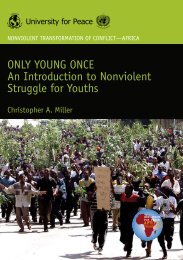who medicines strategy - libdoc.who.int - World Health Organization
who medicines strategy - libdoc.who.int - World Health Organization
who medicines strategy - libdoc.who.int - World Health Organization
Create successful ePaper yourself
Turn your PDF publications into a flip-book with our unique Google optimized e-Paper software.
MEDICINES AND PUBLIC HEALTH | 13Essential <strong>medicines</strong> save lives, reducesuffering, and improve health. But onlyif they are of good quality and safe,available, affordable, and rationallyused. The concept of essential <strong>medicines</strong>encourages health systems to focus onaccess to those <strong>medicines</strong> that representthe best balance of quality, safety, efficacyand cost to meet priority health needswithin any given health care setting. Overthe last 25 years the concept has provento be a global necessity for countries fromthe poorest to the wealthiest.CURRENT CHALLENGES IN A CHANGING WORLDIn 2002, there were almost 6 million deaths fromHIV/AIDS, TB, and malaria. Of the over 1 million<strong>who</strong> died from malaria, most were children inAfrica. In addition, WHO estimates that in 2002over 2 million children in developing countriesdied from perinatal conditions and 4 million diedfrom just three diseases — pneumonia, measles,and diarrhoea. Meanwhile heart disease, stroke,cancer, and other chronic diseases are a majorcause of death in high- and middle-incomecountries, and an increasing problem in lowincomecountries. Yet for nearly all of these majorhealth problems, <strong>medicines</strong> exist that can extendlife and reduce disability.In 2001, the Commission on Macroeconomicsand <strong>Health</strong> estimated that 10.5 million lives peryear could be saved by the year 2015 — alsoboosting economic growth and development— by scaling up access to existing health<strong>int</strong>erventions to prevent or treat infectiousdiseases, maternal and perinatal conditions,childhood diseases, and noncommunicablediseases. Most of these <strong>int</strong>erventions depend onessential <strong>medicines</strong>.Figure 1: 10.5 million lives per year could besaved by ensuring access to existing <strong>medicines</strong>,vaccines, and prevention strategiesNo. of deaths in millionsABCDEA B C D EInfectious diseasesMaternal & perinatalRespiratory infectionsCancersCardiovascular diseases1998 Baseline2015 without Scaling-up2015 with Scaling-upSource: Commission on Macroeconomics and<strong>Health</strong>, WHO, 2001











